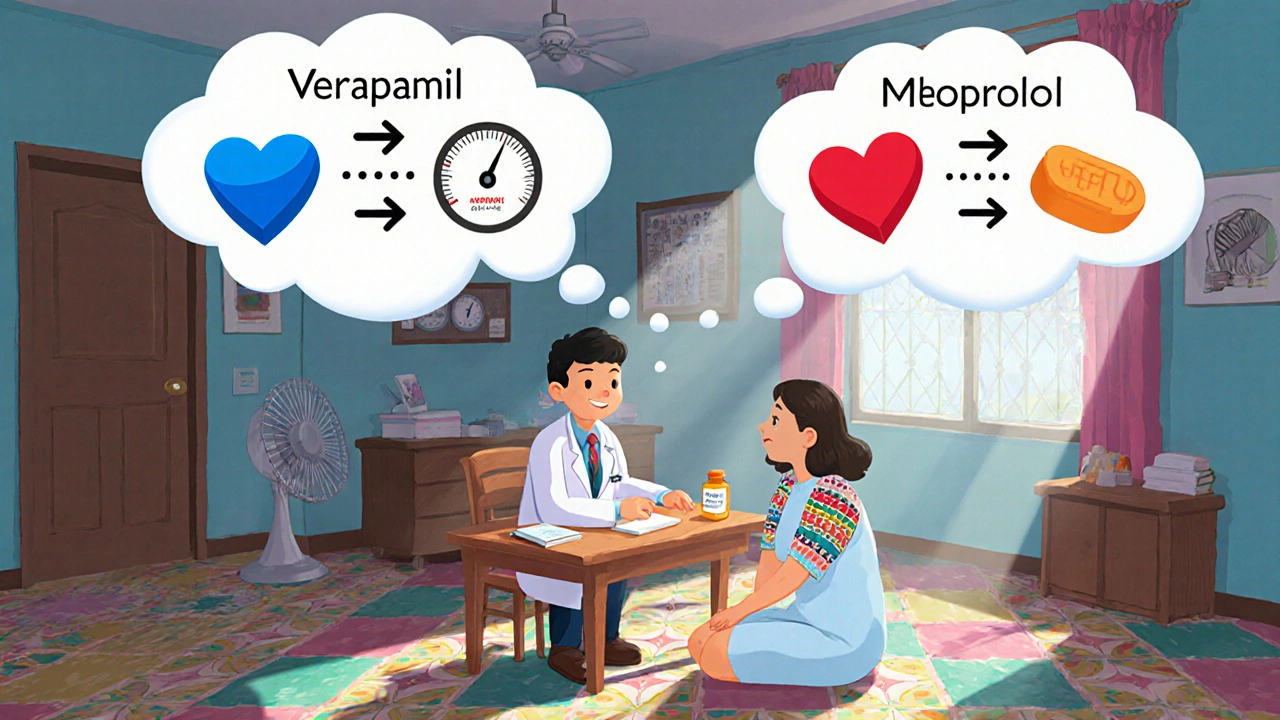Calcium Channel Blocker Selection Tool
Find Your Best Medication Option
Select your specific condition and requirements to see which calcium channel blocker or alternative medication is most appropriate for your situation.
When doctors prescribe Verapamil is a non‑dihydropyridine calcium channel blocker used to treat high blood pressure, angina, and certain heart rhythm disorders, they’re targeting the same pathways that other meds hit, but the details matter.
What makes Verapamil unique?
Verapamil blocks L‑type calcium channels in the heart and blood vessels, which slows electrical conduction and relaxes smooth muscle. This dual action means it can lower blood pressure while also controlling supraventricular tachycardia. Because it works directly on the heart’s conduction system, it can cause a slower pulse-a side effect that isn’t as common with the dihydropyridine family.
Common alternatives at a glance
Below are the most frequently swapped drugs when patients need a different approach.
- Diltiazem is a non‑dihydropyridine calcium channel blocker that leans more toward vascular dilation and less on heart‑rate reduction.
- Amlodipine belongs to the dihydropyridine class, offering strong arterial vasodilation but minimal effect on heart rhythm.
- Metoprolol is a beta‑blocker that lowers heart rate by blocking adrenaline receptors, often paired with calcium blockers for hypertension.
- Nitroglycerin acts as a nitrate, providing quick relief for angina by dilating veins and arteries.
- Lisinopril is an ACE inhibitor that reduces blood pressure through the renin‑angiotensin system rather than calcium channels.
How each drug works - quick cheat sheet
Understanding the mechanism helps you see why a doctor might choose one over another.
- Verapamil blocks calcium entry into cardiac and smooth‑muscle cells, decreasing contractility and slowing conduction.
- Diltiazem blocks the same channel but has a milder effect on the heart’s pacemaker, making it a gentler option for patients with borderline bradycardia.
- Amlodipine blocks calcium primarily in arterial smooth muscle, causing potent vasodilation without touching the heart’s rhythm.
- Metoprolol blocks beta‑1 receptors, reducing heart rate and contractile force, which complements calcium channel blockers for synergistic blood‑pressure control.
- Nitroglycerin releases nitric oxide, relaxing vascular smooth muscle for fast‑acting angina relief.
- Lisinopril inhibits the conversion of angiotensin I to angiotensin II, lowering systemic vascular resistance.

Side‑effect profile comparison
| Drug | Class | Primary Indication | Typical Dosage (mg/day) | Common Side Effects | Key Drug Interactions |
|---|---|---|---|---|---|
| Verapamil | Non‑dihydropyridine CCB | Hypertension, Angina, SVT | 80-480 | Bradycardia, Constipation, Edema | Beta‑blockers, Digoxin |
| Diltiazem | Non‑dihydropyridine CCB | Hypertension, Angina | 120-360 | Headache, Peripheral edema | Cytochrome‑P450 inhibitors |
| Amlodipine | Dihydropyridine CCB | Hypertension, Angina | 2.5-10 | Swelling, Flushing | Grapefruit juice |
| Metoprolol | Beta‑blocker | Hypertension, Heart failure | 50-200 | Fatigue, Cold extremities | Calcium channel blockers |
| Nitroglycerin | Nitrate | Acute angina | 0.3-0.6 (sublingual) | Headache, Hypotension | Phosphodiesterase inhibitors |
| Lisinopril | ACE inhibitor | Hypertension, Heart failure | 10-40 | Cough, Hyperkalemia | Potassium‑sparing diuretics |
When to stick with Verapamil
If you have a documented supraventricular tachycardia (SVT) that needs rate control, Verapamil’s direct effect on the AV node makes it a first‑line choice. Patients who also need modest blood‑pressure reduction usually benefit from the double‑action profile. The drug shines when you want to avoid the peripheral edema that dihydropyridines often cause.
When an alternative might be better
Imagine you’re already on a beta‑blocker and start feeling too slow at the gym. Adding another heart‑rate‑slowing agent like Verapamil could push you into bradycardia. In that scenario, a pure vasodilator such as Amlodipine gives you blood‑pressure control without further slowing the pulse. Likewise, patients with severe constipation may tolerate Diltiazem better because it spares the gut’s smooth muscle a bit more.

Practical tips for switching medications
- Always taper Verapamil over a few days to avoid rebound hypertension.
- Monitor heart rate and blood pressure twice daily for the first week after a change.
- Check for interactions with existing drugs-especially other heart‑rate modifiers.
- Keep a symptom diary: note any new dizziness, swelling, or chest discomfort.
- Have a clear rescue plan (e.g., nitroglycerin tablets) if angina worsens during the transition.
Common pitfalls and how to avoid them
One frequent mistake is assuming all calcium channel blockers are interchangeable. Dihydropyridines don’t affect the AV node, so swapping them for Verapamil in SVT patients can leave the rhythm issue unchanged. Another trap is ignoring dietary influences-grapefruit juice can raise levels of some CCBs, leading to unexpected side effects.
Bottom line
Verapamil remains a versatile tool for doctors dealing with mixed hypertension‑angina‑arrhythmia cases. However, alternatives like Diltiazem, Amlodipine, Metoprolol, Nitroglycerin, and Lisinopril each bring a unique strength that may better suit individual health profiles. The key is matching the drug’s primary mechanism to the patient’s specific cardiac or vascular need.
Can I take Verapamil with a beta‑blocker?
Yes, but only under close medical supervision. The combo can cause excessive slowing of the heart rate and low blood pressure, so doctors usually start with low doses and monitor closely.
Why does Verapamil cause constipation?
The drug relaxes smooth muscle throughout the gastrointestinal tract, slowing peristalsis. Staying hydrated and adding fiber can help mitigate this side effect.
Is Amlodipine safer for older adults?
Amlodipine’s lack of heart‑rate effects makes it a common choice for seniors who already have a slower pulse. However, watch for ankle swelling, which older patients experience more frequently.
What should I do if I miss a Verapamil dose?
Take the missed tablet as soon as you remember, unless it’s almost time for the next dose. In that case, skip the missed one and resume your regular schedule-don’t double up.
Can I use over‑the‑counter pain relievers with Verapamil?
Acetaminophen is generally safe, but NSAIDs like ibuprofen can increase blood‑pressure‑raising effects. Always check with a pharmacist if you need regular pain relief.


Comments (7)
Holly Kress
Great summary of how Verapamil differs from the other calcium channel blockers. The part about the dual action on blood pressure and SVT really helps me understand when it’s the right choice. I also appreciate the tip about tapering to avoid rebound hypertension. Thanks for putting it all together in an easy‑to‑read format.
Chris L
Totally agree-keeping an eye on heart rate when you add a beta‑blocker is key. A gentle reminder to check with your doc before mixing meds goes a long way.
Charlene Gabriel
When you look at the pharmacologic landscape, Verapamide sits at a fascinating crossroads between pure vasodilation and direct cardiac conduction control, which is why it earns a special place in many treatment algorithms. First, the drug’s ability to block L‑type calcium channels in both myocardial tissue and vascular smooth muscle means it simultaneously reduces afterload and slows atrioventricular nodal conduction. This duality is especially valuable for patients who present with both hypertension and supraventricular tachycardia, because you can address two problems with a single pill instead of stacking multiple agents. Second, the slower heart rate side effect, while sometimes inconvenient, actually serves as a therapeutic lever in managing rate‑controlled arrhythmias without resorting to beta‑blockers, which may be contraindicated in certain pulmonary conditions. Third, the gastrointestinal impact, notably constipation, stems from reduced smooth‑muscle tone throughout the gut, a mechanism that can be mitigated with dietary fiber and adequate hydration. Fourth, the drug‑drug interaction profile emphasizes caution with other rate‑slowing agents such as digoxin or other calcium channel blockers, as additive effects can precipitate bradycardia or heart block. Fifth, the metabolism via CYP3A4 means that inhibitors like certain antifungals or even grapefruit juice can raise plasma concentrations, increasing the risk of adverse events. Sixth, the clinical decision to switch from Verapamil to a dihydropyridine like Amlodipine often hinges on the presence of peripheral edema, because dihydropyridines tend to cause more pronounced fluid retention. Seventh, in patients who are already on a beta‑blocker, adding Verapamil without careful dose adjustment may push the heart rate into the dangerously low zone, underscoring the importance of titration and close monitoring. Eighth, the tapering protocol usually involves decreasing the daily dose by 10–20 mg every few days to avoid a rebound surge in blood pressure that can threaten vascular integrity. Ninth, for clinicians, the choice between Verapamil and Diltiazem often comes down to the degree of AV‑node suppression needed, with Diltiazem offering a milder effect that is sometimes preferable in borderline cases. Tenth, the cost considerations can also influence prescribing patterns, as generic Verapamil is generally affordable, yet insurance formularies may favor newer agents, creating a potential barrier for patients. Eleventh, patient education is vital: letting individuals know to report symptoms like dizziness, new fatigue, or excessive swelling can catch complications early. Twelfth, the role of Verapamil in acute coronary syndromes is limited compared to nitrates or beta‑blockers, but it remains useful in chronic angina management when other options are exhausted. Thirteenth, the evidence base shows that long‑term use does not appear to increase mortality, providing reassurance for clinicians hesitant about chronic therapy. Fourteenth, for elderly patients, dose adjustments may be necessary because renal clearance declines, and the risk of constipation becomes more pronounced. Finally, regardless of the chosen agent, the overarching principle is to match the drug’s primary mechanism to the patient’s dominant clinical issue, whether that is blood‑pressure control, rhythm regulation, or symptom relief, and to do so with vigilant monitoring and open communication.
Leah Ackerson
It’s curious how we often treat the heart as if it were merely a pump, ignoring the subtle poetry of its rhythm. Verapamil, in that sense, acts like a quiet conductor, gently coaxing the tempo without demanding applause. Yet some patients mistake any slowdown for weakness, when in fact it can be a protective lull. 🌿🩺 The wise physician knows when to let the heart rest, and when to let it dance. 🤔
Gary Campbell
What most people don’t realize is that the pharmaceutical push for Verapamil isn’t just about patient care; it’s a carefully orchestrated move by big pharma to keep us dependent on brand‑name combos. They hide the fact that the drug’s effect on gut motility is a side effect of a hidden micro‑chip aimed at monitoring compliance. The same companies that market “advanced” calcium channel blockers also fund research that downplays natural alternatives. I’ve seen the papers they suppress, and the data they manipulate. Just stay skeptical and read beyond the glossy brochures.
renee granados
Don’t trust that pill, it’s a trap.
Stephen Lenzovich
The American medical community has long prided itself on pioneering cardiovascular therapies, and Verapamil stands as a testament to that legacy. While overseas clinicians chase after the newest dihydropyridines, we know the value of a drug that can both lower pressure and tame arrhythmias. Our clinicians understand the nuance of dosing and monitoring, something that’s often lost in foreign protocols. Let’s keep the standards high and resist the trend of cheap, flashy substitutes.